The Order of the Rose and the Cross
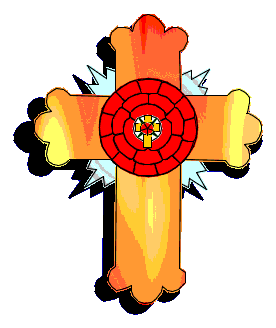
The Rose is the Flower of Life.
The Cross is the 'X' of
As is Above, So Is Below - The Emerald Tablets of Thoth.
The brotherhoods protected the secrets ... until we reached the
evolution of consciousness through the spiraling ladder of our twin DNA helix.
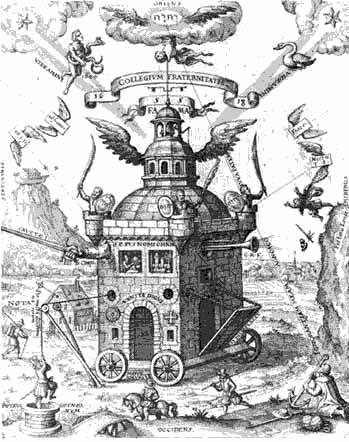
"The Temple of the Rosy Cross", Teophilus Schweighardt Constantiens, 1618
The Rosicrucian is a legendary and secretive order dating from the 15th or 17th century.
It generally is associated with the symbol of the Rose Cross, which is also found in certain rituals beyond "Craft" or "Blue Lodge" Freemasonry.
The Rosicrucian Order is viewed among earlier and many modern Rosicrucianists as an inner worlds Order, comprised of great "Adepts."
When compared to human beings, the consciousness of these Adepts is like that of demi-gods.
This "College of Invisibles" is regarded as the source permanently behind the development of the Rosicrucian movement.
Several modern societies have been formed for the study of Rosicrucianism and allied subjects. However, many researchers on the history of Rosicrucianism argue that modern Rosicrucians are in no sense directly derived from the "Brethren of the Rosy Cross" of the 17th century.
Instead, they are considered to be keen followers. Moreover, some have viewed the 17th century order as a literary hoax or prank, rather than an operative society. Others contend that history shows them to be the genesis of later operative and functional societies.
The Rosicrucian greeting is, "May the Roses bloom upon your Cross."
According to a legend published in the 17th century Rosicrucian manifestos, the Rosicrucian Order was founded in 1407 (the early 15th century) by a German pilgrim named Christian Rosenkreuz (1378 - 1484), who studied in the Middle East under various occult masters. During his lifetime, the Order was alleged to be small, consisting of no more than eight members.
When Rosenkreuz died in 1484, the Order disappeared, only to be "reborn" in the early 17th century. Most modern Rosicrucians accept this legend to varying degrees. Some accept it as literal truth, others see it as a parable, and yet others believe Rosenkreuz to be a pseudonym for a more famous historical figure, usually Francis Bacon.
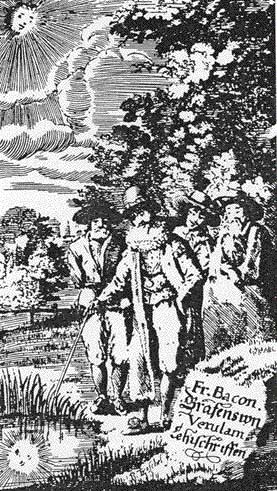
According to a lesser known legend found in Masonic literature, the Rosicrucian Order was created in year 46 when an Alexandrian Gnostic sage named Ormus and his six followers were converted by one of Jesus' disciples, Mark. From this conversion, Rosicrucianism was born by fusing early Christianity with Egyptian mysteries. By this account, rather than being its founder, Rosenkreuz would have been initiated into and become the Grand Master of an already existing Order.
According to Emile Dantinne (1884-1969), the origins of the Rosicrucians may have an Islamic connection. As told in their first manifesto Fama Fraternitatis (1614) (early 17th century) Christian Rosenkreuz started his pilgrimage at the age of sixteen.
This led him to Arabia, Egypt and Morocco, where he was put into contact with the sages of the East, who revealed to him the universal harmonic science. After learning Arabic philosophy in Jerusalem, he was led to Damcar.
This place remains a mystery - it did not become Damascus, but it is somewhere not too far from Jerusalem. Then he went to Egypt, where he did not stay for long.
Soon afterwards he embarked to Fes, a center of philosophical and occultist studies, such as the alchemy of Abu-Abdallah, Gabir ben Hayan, and Imam Jafar al Sadiq, the astrology and magic of Ali-ash-Shabramallishi, and the esoteric science of Abdarrahman ben Abdallah al Iskari.
However, Dantinne states that Rosenkreuz may have found his secrets amongst the "Brethren of Purity," a society of philosophers that had formed in Basra (Iraq) during the first half of the fourth century.
Their doctrine had its source in the study of the ancient Greek philosophers, but it became more pronounced in a neo-Pythagorean direction.
They adopted the Pythagorean tradition of envisioning objects and ideas in terms of their numeric aspects. Their theurgy taught the divine and angelic names, conjurations, the Kabbalah, exorcisms, and other related subjects.
The "Brethren of Purity" and the Sufis were united in many points of doctrine. They both were mystical orders deriving from Koranic theology, where dogma is supplanted by faith in the "Divine Reality." Many similarities with the Rosicrucian way were expressed in the manifestos and the "Brethen of Purity" ways of life as well.
Neither group wore special clothing, both practiced abstinence, they healed the sick, and they offered their teachings free of charge. Similarities also were evident in the doctrinal elements of their theurgy and the story of Creation in terms of emanationism.
The curious legend in which the fabulous origin of the so-called society was established was so improbable, though ingenious, that the genesis of the Rosicrucians was generally overlooked or ignored in the writings of the time.
Christian Rosenkreuz had discovered and learned the Secret Wisdom on a pilgrimage to the East in the 15th century. The metaphorical quality of these legends lends to the nebulous nature of the origins of Rosicrucianism. For example, the opening of Rosenkreuz's tomb is thought to be only a way of referring to the cycles in nature and to cosmic events.
It is on the foundation of these teachings that Rosenkreuz conceived the plan for simultaneous and universal religious, philosophic, scientific, political, and artistic reform. For the realization of this plan, he united with several disciples (seven at first, according to Fama Fraternitatis), to whom he gave the name of Rose-Croix.
The founder of the Order of the Rose-Croix belonged, as affirmed by historians, to a noble family, but there is no document that allows us to affirm this peremptorily.
However, it is certain that he was an orientalist and a great traveler.
What was known in the early 17th century as the "Fraternity of the Rose Cross" seems to have been a number of isolated individuals who held certain views in common, which apparently was their only bond of union.
These views were regarding hermetic knowledge, related to the higher nature of man, and also with common philosophical conceptions towards the foundation of a more perfected human society.
There is no trace of a Fraternity or secret society which held meetings, or had officers or leaders. So far, as many works are concerned, it is evident that the writers who posed as Rosicrucians were moral and religious reformers, and utilized the technicalities of chemistry (alchemy), and the sciences generally, as media through which to publicize their opinions and beliefs.
Their writings included a hint of mysticism or occultism, promoting inquiry and suggesting hidden meanings discernible or discoverable only by "Adepts."The publications of Fama Fraternitatis Rosae Crucis (1614), Confessio Fraternitatis (1615), and Chymical Wedding of Christian Rosenkreutz (1616) caused immense excitement throughout Europe.
These works declared the existence of a secret brotherhood of alchemists and sages who were interpreted as preparing to transform the arts, sciences, religion, political, and intellectual landscape of Europe while wars of politics and religion ravaged the continent.
Not only did these works lead to many re-issues, but they were followed by numerous pamphlets, favourable and otherwise, whose authors generally knew little of the real aims of the original author and often amused themselves at the public's expense.
According to historical records, it is probable that the first work was circulated in manuscript form about 1610, even though there was no mention of the order before that decade. In fact, research indicates that all three documents probably were the creation of Lutheran theologian Johann Valentin Andreae (1586-1654).
However, his authorship only is confirmed for the Chymical Wedding, which he subsequently described as a Ludibrium. The authors of the Rosicrucian works generally favoured Lutheranism as opposed to Roman Catholicism.
Around 1530, more than eighty years before the publication of the first manifesto, documented evidence of the cross and the rose already existed in Portugal in the Convent of the Order of Christ, home of the Knights Templar, which later was renamed Order of Christ.
Three bocetes were, and still are, on the abóboda of the initiations' room. In these cases, the rose can clearly be seen at the center of the cross.
At the same time, a minor writing by Paracelsus called Prognosticatio Eximii Doctoris Paracelsi (1530) contained the image of a double cross over an open rose, along with a written reference to it. The occultist Stanislas de Guaita, "Au seuil du Mystère" (1886), used Paracelsus' writing, and other examples, to prove the "Fraternity of the Rose Cross" existed far earlier than 1614.
It is evident that the first Rosicrucian manifesto, Fama Fraternitatis (1614), was influenced by the work of the respected hermetic philosopher Heinrich Khunrath, of Hamburg. He was author of the Amphitheatrum Sapientiae Aeternae (1609), and was in turn strongly influenced by the work of the mysterious philosopher and alchemist John Dee, author of the Monas Hieroglyphica (1564).
The legend and ideas presented in the first two manifestos and in the "Chymical Wedding" originated a variety of controversial issues and works of Rosicrucianists inspiration.
Among these, are the works of Michael Maier (1568-1622) of Germany, Robert Fludd (1574-1637) and Elias Ashmole (1617-1692) of England and many others, such as Teophilus Schweighardt, Gotthardus Arthusius, Julius Sperber, Henricus Madathanus, Gabriel Naudé, Thomas Vaughan. Some later works with an impact on Rosicrucianism, were the Opus magocabalisticum et theosophicum by George von Welling (1719), of alchemical and paracelsian inspiration, and the Aureum Vellus oder Goldenes Vliess by Hermann Fictuld in 1749.
Michael Maier (1568-1622), a philosopher, alchemist, practical chemist, and a doctor in medicine, was ennobled with the title Pfalzgraf (Count Palatine) by Rudolph II, Emperor and King of Hungary and King of Bohemia. He also was one of the most prominent apologists and defenders of the Rosicrucians, clearly transmitting details about the "Brothers of the Rose Cross" in his writings.
Maier made the firm statement that the Brothers of R.C. actually exist to advance inspired arts and sciences, including Alchemy. The researchers of Maiers' writings point out that he never stated, in an objective way, that he had produced gold. Neither Heinrich Khunrath nor any of the other Rosicrucianists ever said as well.
Their writings point toward a highly symbolic and spiritual Alchemy, more than an operative one. In both direct and veiled styles, these writings conveyed the nine stages of the involutive-evolutive transmutation of the threefold body of the human being, the threefold soul and the threefold spirit, among other esoteric knowledge related to the "Path of Initiation".
Isaac Newton (1642-1727), one of the most important geniuses of mathematics, also possessed many famous and old treatises of Alchemy. He also made manuscript copies of alchemical works, found today at the Yale University's Library.
One of these many works in his collection is the Themis Aurea by Michael Maier, to which he made references and comments about notes relating to hermetic philosophy.
In the 1618 manifesto, Pia et Utilissima Admonitio de Fratribus Rosae Crucis, Henrichus Neuhusius, presented the conception that the Rosicrucians left to the East, due to the instability in Europe at the time of the Thirty Years' War, 1618-1648.
In 1710 Samuel Ritcher, and later on René Guénon, 1886-1951, also presented this idea in some of their works. However, another eminent author on the Rosicrucians, Arthur Edward Waite (1857-1942), presents motifs which contradict this idea.
It was in this fertile field of discourse, and filling the vacuum left by the original Rosicrucians, that many societies said to be "Rosicrucianists" arose. They were based on the occult tradition and inspired by the mystery of this "College of Invisibles." However, it is possible only a few of them may have something in common with the true Rosicrucian Order, other than the name.
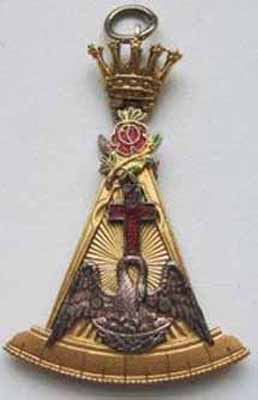
"18° Knight of the Rose Croix" (Masonic's Scottish Rite)
[18=9=Closure of Flower of Life in Time - The Masonic Program]
According to Jean Pierre Bayard, two rites of Rosicrucian inspiration emerged from the end of 18th century. One was the Rectified Scottish Rite, which was widespread in Central Europe where there was a strong presence of the "Golden and Rosy Cross".
The other was the Ancient and Accepted Scottish Rite, practiced in France.
During the 18th century, there were several rites practiced in Freemasonry based on the Renaissance universe of hermeticism and alchemy, which was created by the Rosicrucians of 17th century or earlier.Although many serious research attempts were made to learn about the change from the operative Masonry to the speculative Masonry, no concrete answer has yet been found, other than it occurred between the end of 16th century and the beginning of the 17th century.
Two of the first speculative Masons were Sir Robert Moray (1600-1675) and Elias Ashmole (1617-1692), of a Masonic lodge meeting in Warrington, Lancashire.There is no documented evidence for Chistopher McIntosh's speculation that Robert Fludd (1574-1637) may have been a Mason. Neither is there any documented evidence to suport Arthur Edward Waite (1857-1942) speculating that Fludd may have introduced a Rosicrucian influence into Freemasonry.
However Robert Vanloo states that earlier 17th century Rosicrucianism had a considerable influence on Anglo-Saxon Masonry.
Hans Schick sees in the Rosicrucian works of Comenius (1592-1670) the ideal of the newly born English Masonry before the foundation of the Grand Lodge in 1717.
Comenius was in England during 1641.A point of similarity between the two groups, in continental Europe, is found during the 18th century.
The Masonic circle "Gold und Rosenkreuzer" (Golden and Rosy Cross), published the Geheime Figuren or "The Secret Symbols of the 16th and 17th century Rosicrucians" in 1785 and 1788.
This circle, oriented by Hermann Fictuld from 1777 along Masonic lines, had important branches in Russia, which may have introduced Freemasonry and Martinism into that region.
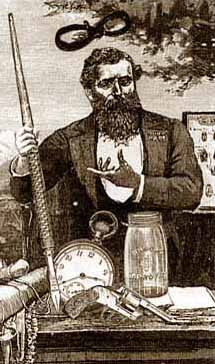
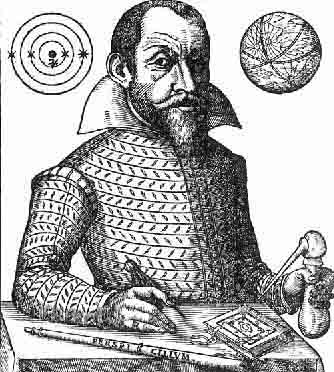
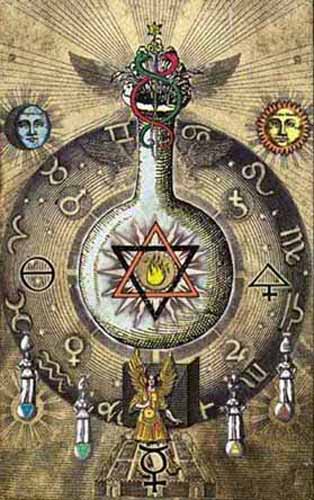
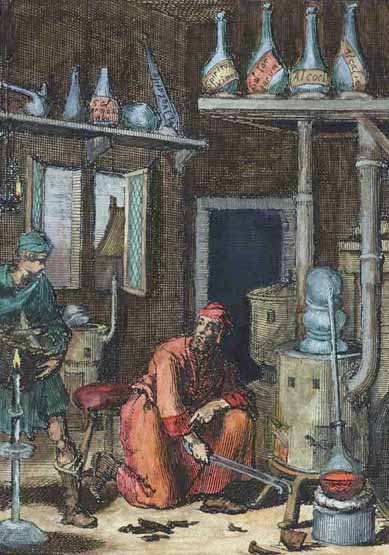
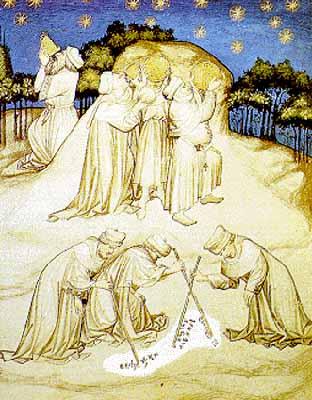
The alchemy in the laboratory (the ancestor of modern chemistry), where the ultimate goal was understanding of the laws of Nature in order to aid the individual's quest for perfection, recalls another type of alchemy, the one called spiritual. The true alchemists, or philosophers of the fire, often make reference in their works to the blowers, meaning all those who were just interested the creation of gold and the material aspects of alchemy.
In his laboratory, the alchemist works on the materia prima and surrounds himself, among other tools to accomplish the operations, of a furnace with a peculiar form, called athanor.
In the point of view of the Spiritual Alchemy, the materia prima is the human soul, and about the athanor, it is constituted by the physical body and the subtle bodies. These last ones maintain the life of the most dense one and assure the connection with the soul.
The laboratory is the human existence during which the soul has the possibility of accomplishing the learning needed to perfect itself, operating the transmutation of the vices and defects of the vil metal into spiritual, that is, into related virtues and qualities.
The first Rosicrucians practiced the operative alchemy, in vogue at that epoch, of interest even to the higher ranks of popes and kings.
The Chymical Wedding of Christian Rosenkreutz is a major written work which clearly makes reference, through its title, to this work on the matter, in the laboratory.

Current-day Rosicrucians (like modern Freemasons, who do not construct cathedrals anymore) direct their concentration toward the work of spiritual alchemy.
According to the early Manifestoes, the Rosicrucians were a "secret" Order. Their members believed or could "demonstrate" healing powers that were believed to be a gift from God: Spiritual Healing.
In other Orders these powers were explained by Egyptian mysteries and again, differently in the Hermetic Order. [Hermes]
Members were admitted on this basis alone and the "membership" was very selective. The writers, philosophers and people of the time became curious and infuriated because they were denied entrance into these secret meetings. Most of the writings of the time are biased or speculative for this reason. Many modern Rosicrucian organizations hold the belief that these God given powers may be used to help others.
Some interpretations are described as being Rosicrucian. They are used as an idea or icon by persons or groups either Gnostic Christian or simultaneously Christian and trans-Christian. An example would be a cult that centers around the Virgin Mary yet openly or secretly identifies her to the Virgo constellation of the Zodiac.
A large majority of modern Rosicrucians believe in the study of Spiritual Astrology as a key to the Spirit, designed toward spiritual development and self-knowledge, as well as an aid to healing through Astro-Diagnosis.
A way through which the alchemical work on the "Path of Initiation" has been expressed to the world, according to occultists as Corinne Heline (1882-1975), is through some of the great compositions of classical music. To wit, the nine symphonies of Beethoven (1770-1827) were divided into two groups.
The first, the third, the fifth, and the seventh are vigorous, powerful and of command, representing the intellect. The second, the fourth, the sixth and the eighth are elegant, ternurent, gracious and beautiful, representing the heart (intuition).
They culminate in the symphony with human voices, the ninth symphony, in which the equilibrium between mind and heart or the "Chymical Wedding" ritual, where the Christ Within the Adept is born ("consumatun est"). Johan Herde speaks of Beethoven as "... God acts on earth through evolved men..." and Beethoven speaks of himself as "... I do not have friends, that is why I must live alone, but I know from the deepest of my heart, that God is closer to me than to others. I come close to Him without fear, because I have always known Him...".
Occultists also point out that many of the works of William Shakespeare (1564-1616), such as the music-dramas of Wagner, Goethe's Faust, Dante's Divine Comedy or Camoens's epic Lusiads, and a few other books of comparable rank, are designed for esoteric as well as exoteric reading. In Shakespeare's works, specific signatures, cryptically conveyed, also are presented.
In Love's Labour's Lost a whole scene is devoted to revealing, in an ingenious way to those possessing the keys, the Rosicrucian connection. The scene closes with a remark addressed to Goodman Dull, a representative of the unperceiving multitude, that during the entire scene he has not spoken a word. "No," comes his response, "nor understood none neither."
If one abstracts from the symbolic associations of the rose and the cross, which have been visioned by many since ancient epochs, it is known that three treatises or manifestos which gave rise to this movement were published in the German language between 1614 and 1616:
- 1614: Fama Fraternitatis
- 1615: Confessio Fraternitatis
- 1616: Chymical Wedding of Christian Rosenkreutz
Between 1614 and 1620, about 400 manuscripts and books were published which discussed the Rose-Croix documents.
The peak of the so-called "Rosicrucianism furor" was reached when two mysterious posters appeared in the walls of Paris in 1622 within few days from each other.
The first one started with the saying "We, the Deputies of the Higher College of the Rose-Croix, do make our stay, visibly and invisibly, in this city (...)" and the second one ended with the words "The thoughts attached to the real desire of the seeker will lead us to him and him to us".
The following lines can be found in The Muses' Threnodie by H. Adamson (Perth, 1638): "For what we do presage is riot in grosse, for we are brethren of the Rosie Crosse; We have the Mason Word and second sight, Things for to come we can foretell aright."
The Rosicrucians took the union of the rose and the cross for their symbol because this union embodies the meaning of their effort and emphasizes the fact that that effort must be made by all men, as the aim of humanity on earth is to attain divine wisdom.
Only two ways lead to this divine wisdom: knowledge and love.
By the rose blooming in the middle of the cross, the whole meaning of the universe is explained: in order to realize its possibilities and become perfect, mankind must develop the capacity for love to the point of loving all creatures and all forms perceptible to the senses; it must enlarge the capacity for knowledge and understanding to the point of comprehending the laws that govern the worlds, and of being able to proceed, through intuition and the loving intelligence of the heart, from every effect to every cause.

During the late nineteenth and early twentieth centuries, various groups styled themselves Rosicrucian. Almost all claimed to be authentic heirs to a historical Rosicrucian tradition. These include the Ancient Mystical Order Rosae Crucis (AMORC), the Confraternity of the Rose Cross (CR+C), Fraternitas Rosae Crucis, the Rosicrucian Fellowship, the Rosicrucian Order Crotona Fellowship, Societas Rosicruciana, the Hermetic Order of the Golden Dawn, Societas Rosicruciana in Anglia, and others as well.
Esoteric Christianity groups vs. Para-Masonic groups
These diverse groups can be divided into two categories: the para-Masonic groups and the Esoteric Christianity groups. There has never been any connection between these two streams.
Para-Masonic groups may be defined as being late heirs of the alchemy and hermetic knowledge created by the original 15th or 17th century "College of Invisibles". The inner structure of these groups is based upon Masonic lines, such as grades, initiations and titles.
The Esoteric Christianity groups regard themselves as representing a "rebirth" in the New World of the inner worlds as described by the original Rosicrucian Order. Their mission is to prepare the whole world for a new phase in Religion during the next six centuries toward the Age of Aquarius.




0 comments:
Post a Comment